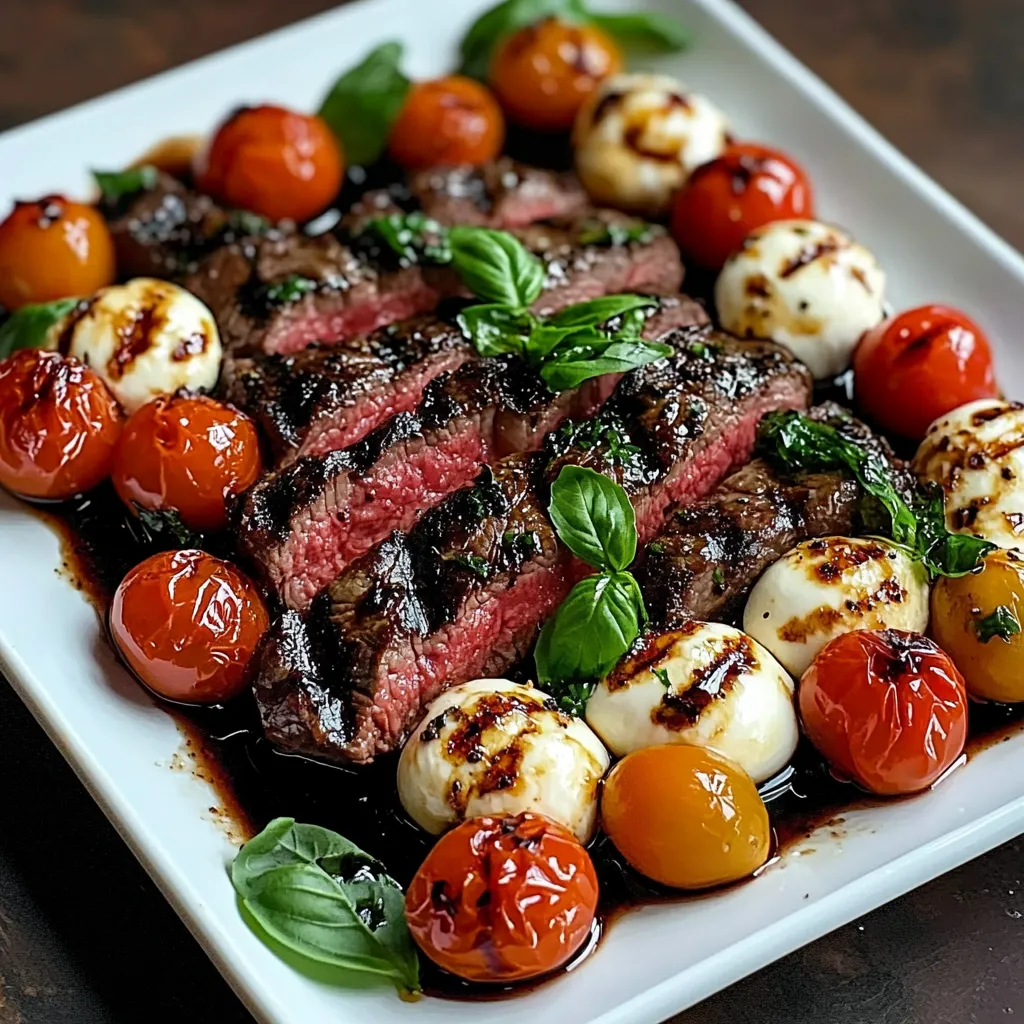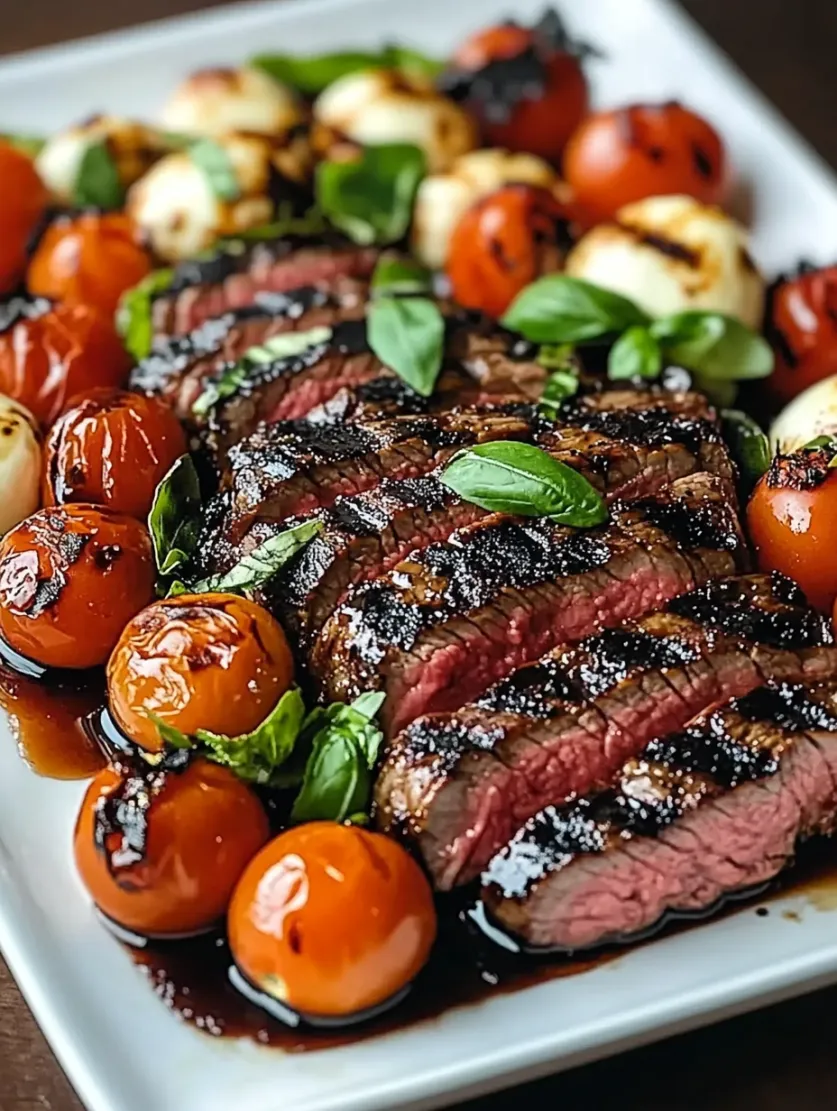 Pin
Pin
This succulent Balsamic Caprese Grilled Flank Steak transforms a humble cut into a restaurant-worthy dinner with minimal effort. The tangy balsamic glaze perfectly complements the juicy steak, while the fresh Caprese topping brings brightness to each bite.
I created this recipe during a summer when our garden was overflowing with tomatoes and basil. What started as a way to use up our harvest became our go-to entertaining dish that never fails to impress guests.
Ingredients
- Flank steak: This affordable cut becomes incredibly tender when marinated and cooked properly. Look for even thickness throughout for consistent cooking.
- Olive oil: The base of your marinade adds richness and helps the steak brown beautifully. Use good quality extra virgin for best flavor.
- Garlic cloves: Fresh minced garlic infuses the meat with aromatic flavor. Buy firm bulbs without any sprouting for optimal pungency.
- Dijon mustard: Acts as an emulsifier in the marinade while adding complexity. French brands tend to have the best tangy profile.
- Cherry tomatoes: Their natural sweetness intensifies when halved. Choose ripe but firm tomatoes that hold their shape.
- Fresh mozzarella: Creamy bocconcini balls provide cooling contrast to the warm steak. Pat them dry before using to prevent watery results.
- Fresh basil: The signature herb that makes this truly Caprese. Look for vibrant green leaves without any black spots.
- Balsamic glaze: Concentrated sweetness that ties everything together. Select a thick, syrupy variety for the best drizzling consistency.
Step-by-Step Instructions
- Prepare the Marinade:
- Combine olive oil, minced garlic, Dijon mustard, salt, and pepper in a small bowl. Whisk vigorously until the mixture becomes slightly thickened and emulsified. The mustard acts as a binding agent that helps the marinade adhere to the meat.
- Marinate the Steak:
- Place your flank steak in a shallow dish or resealable plastic bag. Pour the marinade over the meat, ensuring both sides are thoroughly coated. Gently massage the marinade into the meat fibers. Refrigerate for at least one hour, though four hours will develop deeper flavor. Flip the steak halfway through marinating time.
- Preheat the Grill:
- Heat your grill to medium high heat around 400°F to 450°F. Clean the grates thoroughly and oil them lightly to prevent sticking. For gas grills, preheat with the lid closed for 10–15 minutes. For charcoal, wait until coals are covered with gray ash.
- Grill the Steak:
- Remove steak from marinade, letting excess drip off. Place it on the hottest part of the grill. Cook for 5–7 minutes on the first side without moving it to develop a proper sear and grill marks. Flip once and cook another 5–7 minutes for medium rare to medium doneness. Always use a meat thermometer to check for your desired temperature.
- Rest and Slice:
- Transfer the grilled steak to a cutting board and tent loosely with foil. Let it rest undisturbed for a full 5 minutes to allow juices to redistribute throughout the meat. Slice thinly against the grain at a slight angle to ensure tenderness.
- Prepare Caprese Topping:
- While the steak rests, combine halved cherry tomatoes, fresh mozzarella pieces, and chopped basil in a bowl. Season lightly with salt and freshly ground black pepper. Toss gently to avoid crushing the cheese or bruising the basil.
- Assemble the Dish:
- Arrange the sliced steak on a serving platter. Spoon the Caprese mixture evenly over the top, allowing some to cascade down the sides for a beautiful presentation. Finish with a generous drizzle of balsamic glaze in a zigzag pattern. Serve immediately while the contrast between warm steak and cool topping is at its peak.
 Pin
Pin
The balsamic glaze is truly the magic ingredient in this recipe. I remember the first time I made this for my brother's birthday dinner—he immediately asked for the "secret sauce" recipe and now keeps a bottle in his pantry at all times. That small drizzle transforms simple ingredients into something that feels truly special.
Perfect Doneness Temperatures
Achieving the perfect doneness for your flank steak makes all the difference. For rare, aim for 125°F internal temperature. Medium rare needs 135°F, which I personally recommend for the best balance of tenderness and flavor. Medium comes in at 145°F, while medium well reaches 150°F. Remember that the temperature will rise about 5 degrees during resting time, so remove the steak from heat slightly before reaching your target.
Make-Ahead Options
This recipe works beautifully for entertaining because several components can be prepared ahead of time. The marinade can be mixed and stored in the refrigerator up to 2 days before using. The Caprese topping can be assembled 4 hours ahead, though add the basil just before serving to prevent browning. The balsamic glaze can be purchased ready-made or reduced from regular balsamic vinegar up to a week in advance. Having these elements ready allows you to focus on perfectly grilling the steak when guests arrive.
Serving Suggestions
This versatile dish pairs wonderfully with many sides. For a complete meal, serve alongside roasted fingerling potatoes with herbs or a crusty loaf of artisan bread to soak up the flavorful juices. A simple arugula salad dressed with lemon and olive oil provides a peppery complement to the rich steak. For wine pairings, choose a medium-bodied red like Sangiovese or Merlot that won't overpower the fresh Caprese topping. During summer months, serve this outdoors with a sparkling water infused with cucumber and basil for a refreshing counterpoint.
Recipe FAQs
- → How long should I marinate the steak?
For the best flavor, marinate the steak for 1 to 4 hours. Longer marination intensifies the flavor, but avoid going over 24 hours as it may affect the steak's texture.
- → Can I use a different type of steak?
Yes, you can substitute flank steak with skirt steak, flat iron steak, or ribeye for similar results. Adjust the cooking time based on the cut's thickness.
- → What can I use instead of mozzarella?
If you prefer a dairy-free option, you can use vegan mozzarella or marinated tofu cubes as an alternative.
- → How do I check the steak’s doneness?
Use a meat thermometer to check the internal temperature. For medium-rare, aim for 130-135°F; for medium, 135-145°F.
- → Can I prepare this dish without a grill?
If you don't have a grill, you can use a grill pan or a cast-iron skillet on the stovetop to cook the steak.
